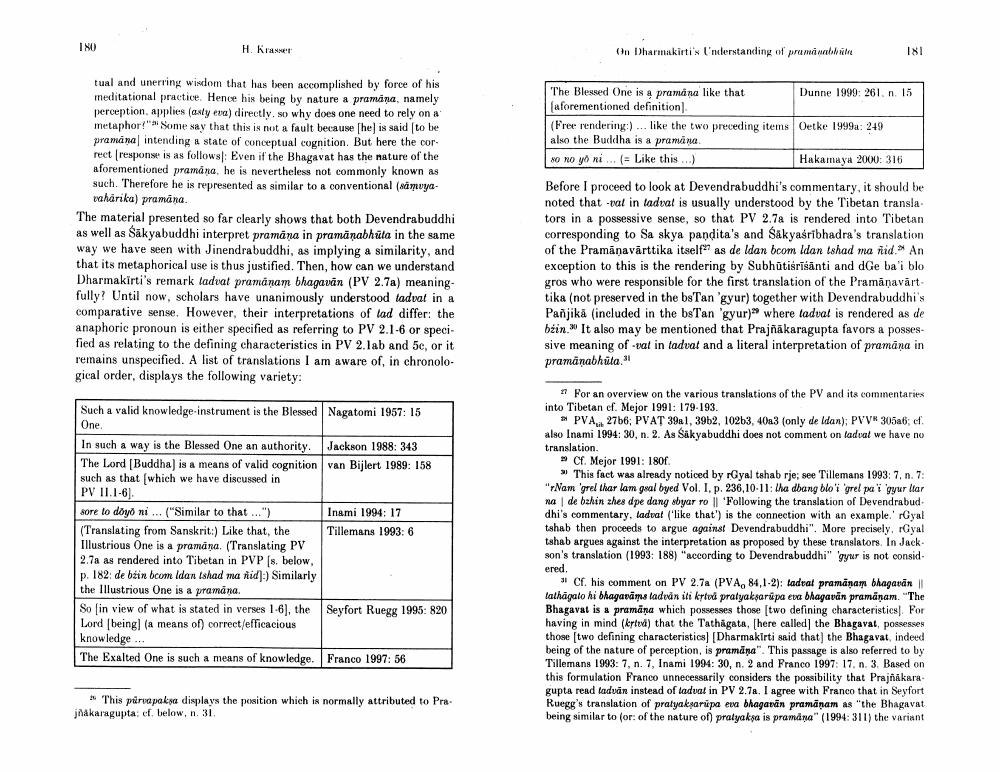Book Title: On Dharmakirtisunderstanding Of Pramanabhuta And His Definition Of Pramana Author(s): Helmut Krasser Publisher: Helmut Krasser View full book textPage 5
________________ INO H. Kramer On Dharmakirtis inderstanding of promānable 181 The Blessed One is a pramana like that Dunne 1999: 261. n. 15 (aforementioned definition) (Free rendering:) ... like the two preceding items Oetke 1999a: 249 also the Buddha is a pramina so no yo ni ... (= Like this...) Hakama ya 2000: 316 tual and unerring wisdom that has been accomplished by force of his meditational practice. Hence his being by nature a pramina, namely perceptionapplies (only eva) directly. so why does one need to rely on a metaphor!" Some say that this is not a fault because she is said to be pramana intending a state of conceptual cognition. But here the correct response is as follows: Even if the Bhagavat has the nature of the aforementioned pramana, he is nevertheless not commonly known as such. Therefore he is represented as similar to a conventional muya taharika) pramāna. The material presented so far clearly shows that both Devendrabuddhi as well as Säkyabuddhi interpret pramana in pramanabhula in the same way we have seen with Jinendrabuddhi, as implying a similarity, and that its metaphorical use is thus justified. Then, how can we understand Dharmakirti's remark ladvat pramanam bhagavan (PV 2.7a) meaningfully? Until now, scholars have unanimously understood tadvat in a comparative sense. However, their interpretations of lad differ: the anaphoric pronoun is either specified as referring to PV 2.1-6 or specified as relating to the defining characteristics in PV 2.lab and 5c, or it remains unspecified. A list of translations I am aware of, in chronological order, displays the following variety: Before I proceed to look at Devendrabuddhi's commentary, it should be noted that -val in tadual is usually understood by the Tibetan transla tors in a possessive sense, so that PV 2.7a is rendered into Tibetan corresponding to Sa skya pandita's and Sakyasribhadra's translation of the Pramāņavārttika itself as de Idan bcom Idan Ishad ma nid.* An exception to this is the rendering by Subhūtisrīśānti and dGe ba'i blo gros who were responsible for the first translation of the Pramāņavārttika (not preserved in the bsTan 'gyur) together with Devendrabuddhi's Panjika (included in the bsTan 'gyur) where ladval is rendered as de bein." It also may be mentioned that Prajñākaragupta favors a possessive meaning of -vat in tadvat and a literal interpretation of pramana in pramanabhūta. Such a valid knowledge instrument is the Blessed Nagatomi 1967: 15 One. In such a way is the Blessed One an authority. Jackson 1988: 343 The Lord (Buddha) is a means of valid cognition van Bijlert 1989: 158 such as that which we have discussed in PV II.1.6) sore lo doyo ni ... ("Similar to that ...") Inami 1994: 17 (Translating from Sanskrit:) Like that, the Tillemans 1993: 6 Illustrious One is a pramana. (Translating PV 2.7a as rendered into Tibetan in PVP (s. below, p. 182: de bžin bcom Idan Ishad ma niid):) Similarly the Illustrious One is a pramana. So sin view of what is stated in verses 1-6), the Seyfort Ruegg 1995: 820 Lord [being] (a means of) correct/efficacious knowledge ... The Exalted One is such a means of knowledge. Franco 1997:56 17 For an overview on the various translations of the PV and its commentaries into Tibetan cf. Mejor 1991: 179-193. PVA 27b6; PVAT 39a1, 39b2, 10263, 4023 (only de Idan); PVV 305a6; cf. also Inami 1994:30, n. 2. As Sakyabuddhi does not comment on tadual we have no translation. » Cf. Mejor 1991: 180f This fact was already noticed by Gyal tahab rje; see Tillemans 1993: 7. n. 7: "rNam grel thar lam gral byed Vol. I. p. 236,10-11: lha dbang blo'i 'grel a gyurlar na de bzhin zhes dpe dang sbyar roll 'Following the translation of Devendrabuddhi's commentary. ladvat like that') is the connection with an example.' royal tshab then proceeds to argue against Devendrabuddhi". More precisely, Gyal tshab argues against the interpretation as proposed by these translators. In Jackson's translation (1993: 188) "according to Devendrabuddhi" gyur is not consid ered. 11 Cr his comment on PV 2.7a (PVA, 84,1-2): Ladeal pramanam bhagavan tathagalo hi bhagavāms tadvan ili krivi pratyaksarupa eva bhagavan pramanam. "The Bhagavat is a pramana which possesses those two defining characteristics For having in mind (krted) that the Tathāgata, [here called the Bhagavat, possesses those two defining characteristics) (Dharmakirti said that the Bhagavat, indeed being of the nature of perception, is pramāna". This passage is also referred to by Tillemans 1993: 7, n. 7, Inami 1994:30, n. 2 and Franco 1997: 17. n. 3. Based on this formulation Franco unnecessarily considers the possibility that Prajñakara. gupta read ladvan instead of ladval in PV 2.7a. I agree with Franco that in Seyfort Ruegg's translation of pratyaksarupa ewa bhagavan pramanam as "the Bhagavat being similar to (or: of the nature of) pratyaksa is pramana" (1994:311) the variant * This pirvapaksa displays the position which is normally attributed to Pra. jNakaragupta cf. below, n. 31Page Navigation
1 ... 3 4 5 6 7 8 9 10 11 12 13 14
